Are There Penguins in Antarctica?
There is always a confusion about the penguins’ domicile. There are also a lot of illusions contributing to the mix-up. Coming to the topic, are there penguins in Antarctica? Yes, of course, penguins live in Antarctica. There are 17 species of living penguins. Amongst them, seven species are habitats of Antarctica.
Penguins Species in the Antarctic:
Antarctic penguins are the species of penguins that live in the Antarctic continent. They live in the icy land and also breed in the frigid atmosphere. The following are the penguin species that are found in and around the Antarctic.
1) Emperor Penguin:
Emperor penguin is the biggest of all the living penguin species. An adult emperor penguin can reach 45 inches tall and weigh about 23 kg. Males are slightly heavier than females. The special adaptation techniques help the species thrive in extremely cold conditions.
Emperor penguins are good divers and swimmers. They can effectively travel long-distance underwater to reach the food. They swim at a speed of 3.4 m/s (7.6 mph). They can stay underwater for around 20 minutes. The appearance of the emperor penguins is dignified and majestic. Their average lifespan is around 15 to 20 years.
The usual diet of emperor penguins is squid, krill, crustaceans, and small fishes. Predators of the species are leopard seals and killer whales. Skuas and giant petrels grab the eggs and the chicks for food.
Like any other penguin species, emperor penguins also experience the threats caused by humans. Overfishing, oil spills, global warming are being the pressures faced by the beautiful flightless bird.
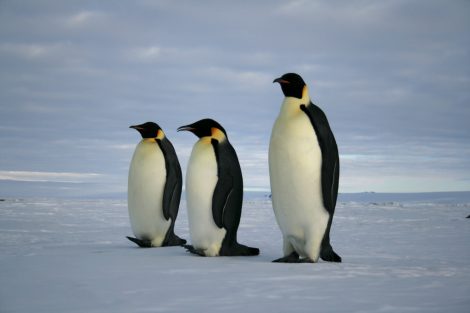
2) Gentoo Penguin:
Gentoo penguins are the third largest of the living penguins after emperor and king penguins. They are the habitat of the Falkland Islands and sub- Antarctic islands. Their close relatives are Chinstrap and Adelie penguins.
Gentoo penguin does not breed on icy lands. The wide white stripe on the head and bright orange bill make them easy to be recognized. Gentoo penguins are also called as long-tailed penguins since they have a long tail sticking behind. They swim fast underwater and reach a speed of 36 km/h.
They mainly prey on krill and less on fish. The predators of Gentoo penguins are leopard seal, sea lion, and killer whales. Chicks and eggs are majorly targeted by skuas, giant petrels, kelp gull and snowy sheathbill.
By the climatic threat, the species are endangered and are in the fast-declining species list. The numbers in Bird Island and South Georgia have found to be the significant places where Gentoo penguins are drastically reduced.
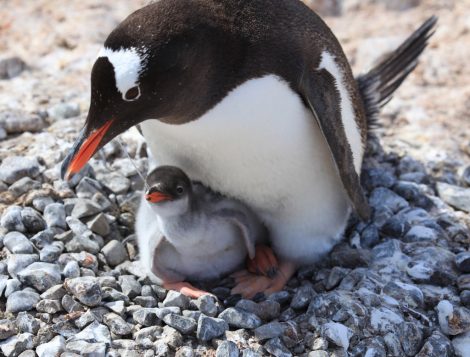
3) Chinstrap Penguin:
Chinstrap penguins are endemic to Southern Pacific and Antarctic Oceans. It also has different names such as bearded penguin, stone cracker penguin, and ringed penguin due to their varied characteristics.
The black stripe under the bill gives a look that they wear a helmet and this pattern makes them easy to identify from other penguin species.
They reach tall to the height of 72 cm and weigh around 3 to 5 kg. Chinstrap penguins swim up to 80 km in search of food such as krill, fish and squid. Chinstrap penguins make a circular stone nest.
Leopard seal and killer whales prey on adult Gentoo penguins whereas brown skuas, giant petrels and snowy sheathbill prey on eggs, chicks and sick Gentoo penguins. Chinstrap penguins are one of the most aggressive penguin species.
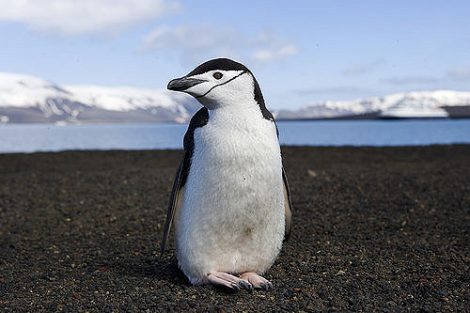
4) Adelie Penguin:
Adelie penguins are the habitat of the only Antarctic coast. They may reach tall to a height of 71 cm and weigh up to 6 kg. They can swim at a speed of 8 km/h. Adelie penguins have a distinct white ring around the eyes and a fully black head with white coloration on the bill.
They have a long tail and it comes under the mid-sized penguin species. They are southerly spread like other seabirds such as emperor penguins, snow petrel, Antarctic petrel, south polar skua and Wilson’s storm petrel.
Adelie penguin’s diet includes Antarctic krill, ice krill, Antarctic silverfish, sea krill, and glacial squid. They make a nest with piled stones. Also, they breed on the ice-free land. The species are threatened by global warming and other human-caused dangers.
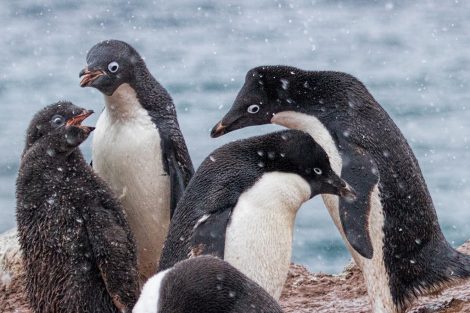
Far South Sub-Antarctic Island Penguins:
5) King Penguin:
King penguin is the second-largest penguin species next to the emperor penguin. They are similar in appearance. They are distributed in the sub-Antarctic islands like the Falkland Islands, Prince Edward Islands, and the Crozet
They have orange coloration under the bill and a bright orange patch on the sides of the head. The yellow-orange coloration below the neck on the throat makes them different from the closest emperor penguins.
King penguin reach to the height of 100 cm and weigh up to 18 kg. Their diet list consists of krill, squid and small fish.
Leopard seal, sea lions and also orcas are the predators of adult king penguins. Seabirds such as giant petrels, skuas, kelp gull, and snowy sheathbill are the major threat to the eggs and chicks. They are also endangered by climatic changes, oil spills and less abundance of the food sources.
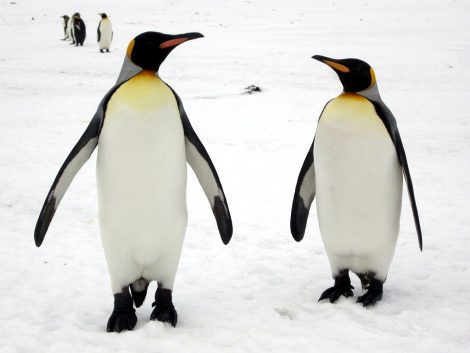
6) Rockhopper Penguin:
Rockhopper penguins are related to the crested penguin species. They reach tall to the height of 20 inches and are one amongst the smallest species of penguins.
Northern rockhopper penguins breed in the cold conditions of the Atlantic Ocean, St Paul and Manchester in the Indian Ocean; Whereas, Southern rockhopper penguins breed in the Falkland Islands, Argentina, and Chile. They make nests in tall grasses called Tussocks.
They prey on lobsters, crabs, fish, or squid. They consume much krill than fish. Rockhopper penguins are endangered by fur seals, leopard seals, blue sharks or killer whales. Predator seabirds include gulls, giant petrels, skuas, and sheathbills.
Rockhopper penguin species are endangered by the changes in surface temperatures, overfishing and ocean water pollution.
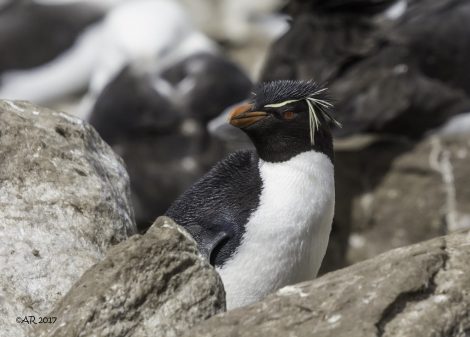
7) Macaroni Penguin:
Macaroni penguins are found from the sub- the Antarctic to the Antarctic Peninsula. The length of the species is 70 cm and they weigh around 5. 5 kg. Male Macaroni penguin has a bigger bill than the female.
It is the largest of all crested penguins. They make shallow scrape nests and breeds in the largest colonies. Macaroni penguin’s diet includes krill, small fish and cephalopods.
Predators of Macaroni penguins are leopard seal, Antarctic, and sub- Antarctic fur seals, killer whales, skuas, giant petrels, snowy sheathbill and kelp gull.
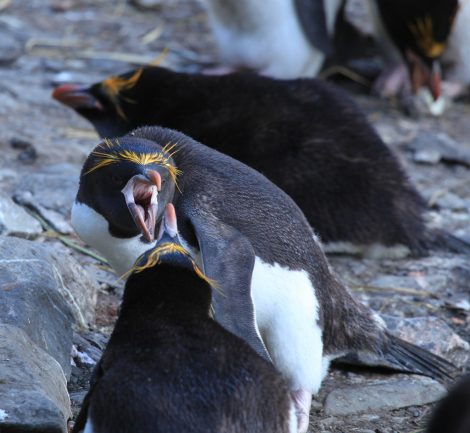
Conclusion:
The Antarctic is colder and drier for the above penguin species to live. Not every penguin lives in the frigid climate. There are many other penguins’ species live in temperate regions as well. The Antarctic doesn’t have any native human population.
Most commonly many species of penguins lack the fear of humans. During an expedition to Antarctica, you can find the above species waddling in the shorelines and icy lands. Due to the decrease in a food source as a result of climatic changes, overfishing and krill industry involvement, the cuddly flightless birds are under severe risk.
There are steps taken by the government to conserve the penguins in Antarctica and other places. Penguins in captivity thrive longer years than the penguins in the wild. Also, there are steps taken by the zoos and wildlife organizations to adopt severely declined penguin species of Antarctica under captivity.
References:
http://www.antarctica.gov.au/about-antarctica/wildlife/animals/penguins
https://www.bas.ac.uk/about/antarctica/wildlife/penguins/
https://blog.oup.com/2012/07/antarctic-geopolitics-penguins-vsi/
Image source:
- Emperor penguins by lin padgham / CC BY
- Gentoo penguin and chick by Liam Quinn / CC BY
- Chinstrap penguin by Christopher Michel / CC BY
- Adelie penguin group by Kathleen / CC BY
- King penguins by David Stanley / CC BY
- Rockhopper penguin by Anita Ritenour / CC BY
- Macaroni penguins by Liam Quinn / CC BY
